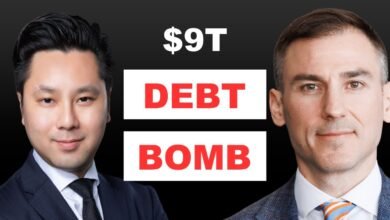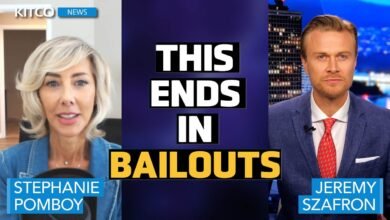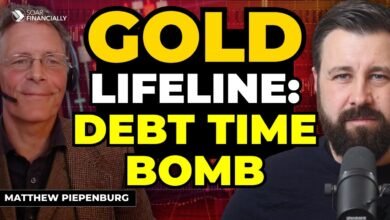Gold’s Record-Breaking Run: What’s Next for This Historic Rally? (Uncut) 02-12-2025
Gold’s Record-Breaking Run: What’s Next for This Historic Rally? The Chart Says It All | Gary Wagner
Hey everyone, welcome back to Kitco News, I’m Jeremy Safran. Well, just over a month ago, we had Gary Wagner on our show and he predicted that gold would dip to around $2,650 before rebounding past the $2,800 mark and that’s exactly what happened, though the correction was shallower than expected and today, in response to Federal Reserve Chair Jerome Powell’s testimony in Congress, gold initially declined but has erased most of its earlier losses, signaling strong underlying demand. Now with prices hovering around $29.30 on the future side, the big question is whether gold is gearing up for another breakout or if we’re due for a pullback and the macro landscape is also shifting very fast here.
We had Fed Chair Jerome Powell just signaling that he’s in no rush for rate cuts, keeping pressure on the markets, also Trump’s 25% tariff on tax and aluminum is also adding to inflation risks and again, this just as gold hits new highs. And then we got this new story out of China, how it’s launched a $27 billion gold investment program furthering fueling demand. So is it still positioned for a move closer to $3,000 or are we going to see some short-term exhaustion here? Let’s break it all down and get to the charts with our very own Gary Wagner, editor of the Gold Forecast, joining us from Hawaii.
Good to see you, my friend, it’s been a minute. It has, good to see you also. Really exciting times for gold traders.
Oh my goodness, Gary, I bet. I bet you’re pumped every morning. I mean, the last time you were here, I just kind of alluded to, you called for one more dip before gold’s breakout and that’s exactly how it played out today.
We saw that little decline early, but a recovery for most of its losses. Gary, does the intraday price action tell us anything about the market strength or are we just still on a clear uptrend? I think what the intraday price structure tells us more than anything else is, and today is a great example. We saw gold prices dip in response to testimony by Chairman Powell, but traders quickly stepped in.
They bought the dip. They’re hungry to get involved in gold, to be active in this market. This is truly a historical time and what that intraday data tells me, at least, is there are traders waiting for that dip so they can buy it and take advantage of it because we saw how quickly gold rebounded and that’s happened on other days where we’d see it trade lower overnight.
When it got to New York, they would quickly make up that difference and bid it back to positive ground. You mentioned history. You and I have been talking about this for over a year.
We’ve been making history in that year and yet here we are. We’re almost at $3,000. It seems like a very important level here.
Talk to me about the key support and resistance levels you’re watching and let’s bring up that chart and get into it here, Gary. Certainly. The first chart that we’re going to look at is a weekly standard candlestick chart.
What’s interesting is you can see for the last seven consecutive weeks, of course, this week is new. We’ll have to see if it finishes strong on this week, but we’ve really seen the market move up and in terms of the rally itself, this rally has witnessed gold gain from the middle of December to the high that came in this week of about $370. That’s a 14% rise.
That is strong. Now this is what I said is standard candlestick chart. If I convert it to what’s called a Henkin Ashi and a Henkin Ashi just draws the candles a little bit different.
What we look for in this, the difference between these two types of charts is how the open is fixed. On a standard bar or candlestick chart, the open is fixed on the true opening bid, opening price. On this type of chart, the open is fixed from the midpoint of the prior candle.
On a weekly chart, this open represents the midpoint of the previous week. What that does is really smooth this out so that you don’t get the scenario where you see red and green candles, but you’ll get solid green or solid red. We’ll go ahead and convert it back into a standard candlestick chart.
What’s interesting is that right now, what we’re witnessing is where these two charts are showing solid green. This has been a strong rally. This is a new leg and it followed the correction that we saw with gold trading down, just breaking below 2,600 for a brief moment, and then trading sideways, moving back up.
This is very strong. Very strong. Today’s price action is obviously, it’s a bullish signal.
Some would question if it’s showing a little hesitation to get to that 3,000. What are your thoughts here? I’ve converted our chart back to a daily chart, and this is what you’re talking about right here. Now, it came in and gold made the highest high on record, right around $30 shy of that elusive $3,000, and that’s a key benchmark.
Any of those big numbers, 1,000, 2,000, 3,000, are going to be key psychological levels. The interesting thing is when we look at gold, and I’ll compress this chart, ever since we hit the all-time record high back on October 30th, we traded lower and sideways for a while, but once we broke above that, and that is this key point right around here, you can see gold really took off with a fever. Now we are definitely in uncharted territory.
Gold has never had this high of a value in terms of a troy ounce, and we are in striking distance of 3,000. It came very, very close on an intraday basis this week. I think that in terms of, will gold go to 3,000, my response to that is it’s not if but when.
I’m certain that gold will go there, and I think relatively soon, because gold is still reacting to the key fundamental elements that have been the recent drivers, and that’s really tariffs by the new administration. Yeah, interesting. Okay, so the outlook, we’re still going to get $3,000 gold.
How far is it going to go before we have a little pullback, or as I guess, again, uncharted territories, the macro environment shifting every day, it seems. That’s a lot harder to answer than how high will gold go over a month or this year or within the next three months. That to me is an easy question to answer, because in my opinion, we will see some sort of a pullback or correction.
We typically do. However, we haven’t. If you look at this entire run from the middle of December up till now, there’s really only been brief periods of about a day back on Friday, January 10th.
That was followed on Monday by a lower day. That’s this red candle here. Here you have almost an inside day.
Here you have a day in which it sold off for one day and returned, one day and returned, one day and returned. In other words, with the exception of right at the beginning of this rally, we have never had two consecutive days of lower pricing in gold. The fact that we have a lower price today is not enough information to say that, yes, this is the beginning of a correction.
We would have to see follow through, and even two days wouldn’t give us enough information because we’ve seen that before, and then it kicked right back into bullish momentum. That’s why I like to view these candles through Henkin Ashi, because this is the best way to see a strength of trend. What we look for is body size and the absence of lower wicks.
The reason we look at whether or not these candles have a lower wick is what it is saying is when there is no lower wicks, it says that at no time during the trading session did prices go at or below the midpoint of the prior candle. That’s a strong statement. When we look right around January 30th, the end of January, the candle sizes really, really boost stuff.
When we think about it, that’s 10 days after the inauguration. We saw gold kind of get very quiet just following the inauguration, and then as the executive orders began to fly, market participants reacted with their confident vote against the safe haven asset, which is gold. That’s exactly what we saw.
Momentum is still there. This will lag behind real-time data, so it won’t be until we actually see some kind of the beginning of a pullback that we’ll see that referenced in the charts. But nonetheless, this trend definitely appears to have some real steam left to it and some real momentum as seen through the eyes of this chart type, the Henkin Ashi.
Right. Yeah, well said, Gary. And then, of course, we’re also seeing these major macro forces driving the market, too.
You mentioned a couple of them. Powell says that the Fed is in no rush to cut rates. He told the Senate Banking Committee Tuesday, and I quote, “…with our policy stance now significantly less restrictive than it had been and the economy remaining strong, we do not need to be in a hurry to adjust our policy stance.” So, you know, to your point, it’s looking bullish, but could this possibly slow gold’s momentum, or does it reinforce the long-term bullish case? Well, I think it reinforces the long-term bullish case, but realize where the Federal Reserve is concerned, it’s data dependent.
So we have the CPI coming out later this week. We have the producer price index, the PPI, coming out later this week. And what market participants are going to focus on is whether or not they’re seeing any uptick in inflation, because the greatest fear from levying tariffs, which are just starting to hit, there’s a lag between when they’re implemented and when we as consumers see differences in the price we’re paying for goods, but whether or not that translates to inflation moving higher.
Because if that happens, the Fed’s going to have a patience, but they’re also going to have to be ready to react to any real upticks in inflation. And since tariffs really evoke the possibility of inflation heating back up, that’s what everybody is going to be waiting for, and that’s what could change the narrative from what we’re looking at now, would be a dramatic change in inflation. Yeah.
Yeah. I mean, you’re mentioning that Trump’s 25% tariff on steel and aluminum, you know, historically tariffs have triggered inflation to your point. There’s no word on bullion tariffs yet.
Of course, we’re keeping an eye, but there seemed to be a little fragility in the market. It’s worked the kinks out. But Gary, I got to ask you this question because there’s this new story playing out.
For the first time, China is allowing its major insurance firms to invest in gold, opening the door to billions of dollars in new demand. Under the pilot program, 10 of China’s largest insurers can allocate up to 1% of their assets to gold, as I mentioned, potentially unlocking $27 billion in buying power. Now, this move is significant because it signals that China sees gold as a critical store of value amid their ongoing economic uncertainty.
I mean, the country’s facing struggling real estate sector, limited investment options. Institutional gold buying could become maybe a longer term trend rather than just a short term spike here. Do you see this policy, Gary, having a sustained impact on global gold demand or will issuers only step in during price dips? That announcement came out very recently.
I believe it was yesterday when I first saw that in the news cycle that they really opened it up to the insurance companies to allocate a percentage of their portfolio into the safe haven asset gold. And one, my question is, well, how are they going to put those investment dollars? Are they going to be in electronically traded funds? Are they actually going to be buying physical and storing it? I would imagine it might be a combination, but it seems likely they would use the electronically traded funds to do that, GLD and whatnot. It certainly changes the landscape in terms of overall demand and that it adds something.
And the something it’s adding is substantial. It’s in the billions, not millions. And it certainly could influence the landscape.
It certainly could add to the fire that has ignited this bullish market sentiment. It’s certainly not going to diminish any of the bullish sentiment. So it will be a component.
It’s not a game changer, but it’s certainly an addition. And in the eyes of traders like myself that are bullish on gold, it’s a welcome change because the more we see large institutional plays, we know that that demand continues to grow and we know that that’s going to add to the scarcity of the metal that people are already talking about because gold has been so hot, because we’ve seen it move up substantially. I mean, just since the middle of December, we’ve seen a 14.14 percent gain in the price of gold.
I would venture to say that’s outperforming most of the indexes as well as equities, equity indexes, maybe not certain equities or certain stocks itself that are hot, but that performance is exceptional. 14 percent over a period of under two months really shows you that it’s on fire. And resilient, too.
I mean, you add in these macro stories we’re talking about. We have this bullion surge going from London over to New York. And then, of course, we have these new opportunity for Chinese buyers.
I’m curious, you brought up that chart and we got to ask you, I mean, in the next month, where do you see the upside here? Where do you think gold is going to go? Because once we get past the $3,000 barrier, it almost feels like it is going to be a little bit more cautious, a little bit slower, do you think? Or is it going to just go fast? Well, the first thing is that I’ve got to say is that when we are in uncharted territory, which we absolutely are, as a market technician, you’ve basically pulled one of my best tools out of my toolbox, which is to look at how a stock or commodity, in this case gold, reacted at that price point. And once it went above $2,800, which is this top right here, well, we have no historical data to really reference that to. So what I’ve done on this chart is I’ve looked at key rallies that occurred, this one at the end of November of 2023, this one is what I’m calling the February to April rally.
This is the largest rally last year, $451, a total gain of 22%. The next one is through August and September, that’s a 16% rise at $375. So when we compare these rallies to this current rally that’s already moved about $370, if it equals the largest rally last year, it’s got another $150 to go.
I think $3,000, as I said, is not if but when. I think that that would be a logical point if we haven’t seen gold have any sort of pullback or correction, that might be a logical point to look at because typically when they go and make new all-time record highs in one of 3,000, which is going to carry some weight, it does give shorter term traders the motivation to pull profits and bank those profits. However, we haven’t seen that, that’s the whole thing.
When we look at the trajectory of gold, the one thing that we can say is that this recent rise, and it depends on how you compress the chart, but if you look at the tact or the angle on this, it’s almost a, what a straight 45%, I mean, it’s almost parabolic. And so parabolic up always gives the potential for a hard correction, but we haven’t seen it. And the reason this time is different from other times where we would typically see a pullback much sooner is that the fundamentals driving this are strong because we have a new administration, which has created a tremendous amount of uncertainty.
We’re getting some clarity as he’s passed these executive orders and we see what he’s focusing on, but the whole idea in terms of what he’s doing with tariffs is genuinely troublesome or worrisome because it could lead to a global trade war. It’s certainly going to lead to higher prices, not just for those in North America and Canada and the United States, but globally because tariffs are being reciprocated. And that’s what he spoke about.
He wants reciprocal tariffs, which means that citizens around the world can look forward to higher pricing in the goods that they need every day. And it’s not just going to be confined to just North America or Europe or Canada or Mexico or China, but all citizens. And that to me is worrisome, but it’s all about if it leads to inflation, because if it does, that’s putting yet a new cog in the wheel and a new variable that we haven’t really had to deal with since, what, March of 2022 when inflation got way out of hand and the Fed stepped in and moved interest rates from zero to 5% to bring it down close to between 3% and 4% with their target of 2%.
But we weren’t looking at 9% or 7% or really excessive inflation in terms of what we’ve gotten used to. So that’s the wild card. And it’s a strong wild card in that.
Yeah, absolutely. And then, of course, Jerome this morning saying that, again, we have no need to hurry to adjust our policy stance. Okay, Gary, before I can let you go, I got to ask you your thoughts on silver.
I know we have a lot of viewers watching that metal carefully. They’re always curious about the price action, what’s happening there. It’s been a little bit lackluster.
Tell me what your thoughts are. Silver is not that it’s been hard to predict, but this is a daily. Let me move this to a weekly.
Yeah, you were bearish last time. Still bearish, I take it, yeah? Well, it’s relatively speaking, I still am bearish. I mean, it certainly hasn’t performed like gold has, where what we saw in gold was moving to record highs and then breaking those highs.
I think gold has hit seven all-time new record highs this year alone, but you can see it peaked out around 33. And when we pull this chart back, we can see that that’s higher than silver has been for years. And we have to really go back to the other historical time when both gold and silver did miraculous things.
And that was middle of 2011 to 2012. And this is when silver topped around $48 to $50. We have not seen it.
When we look at this price, the highs that came in, well, as recently as November, that matches these tops that came in between 2012 and, well, really just 2012. There’s hard resistance at 35. It hasn’t challenged 40 or 50.
So if your question is, am I still bearish on silver? I’m still cautiously bearish. I haven’t seen any real moves in silver that have challenged any of the recent highs, although it took out a high of $34. But even that is still below the all-time record high of $50.
And so I cannot be as bullish on silver as I am on gold because gold is definitely reacting as a safe haven asset. And investors are flocking to the precious yellow metal. They’re not doing the same with silver.
Silver has an industrial component that’s greater than gold. But we can see that that’s been tepid at best. It has moved silver from $18 to $35.
And it was sitting at $18 in August of 2022. So that’s almost a doubling of price. And that’s a substantial move, but still below any of the key all-time record highs that we saw a few decades ago.
Yeah, still waiting on $50. A lot of patient bag holders there. Okay, Gary, you’ve been incredibly accurate with your gold calls now.
We’re looking at that 2,900-plus gold, 3,000 in sight. Thanks for this. Credit I went back on the tape and it’s been incredible watching your calls just come into fruition here.
So thanks again, Gary. Thank you so much for having me. I look forward to coming back and we’ll do another update and see where it goes.
For those of you following the precious metal space, make sure you don’t miss our latest updates. Now hit the subscribe button and turn on notifications so you stay ahead of the biggest moves in gold, silver, and the global markets. I’m Jeremy Saplin for all of us here at Kidco News.
Thanks for watching. We’ll see you next time.




